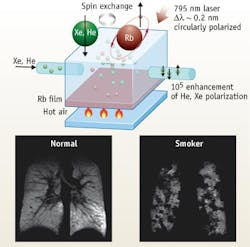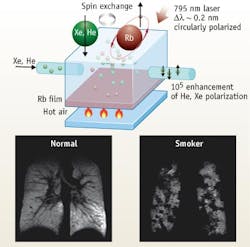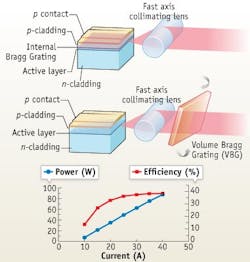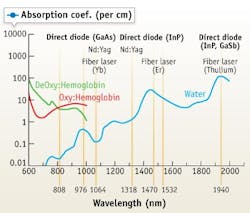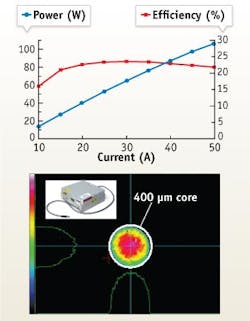Bright laser diodes combat cancer
Recent discoveries based on hyperpolarization of inert gases for enhanced MRI and improved efficacy of long-wavelength laser energy for surgery are enabling earlier and more-accurate diagnosis, as well as alternative treatment for lung cancer. In both cases, laser-diode advances are facilitating the progress.
By LAURENT VAISSIÉ
Power consumption and cost (both initial investment and lifetime service) issues have made semiconductor laser diodes increasingly popular for biomedical applications. But diode lasers offer other benefits too, including technical performance and ease of use. The latest versions are able to supply spatial and spectral brightness sufficient to design new procedures and applications that are pushing medical therapy and diagnostics into uncharted territory. Chief among them is early diagnosis and treatment of cancer. As a couple of examples show, compact, efficient, and low-cost direct-diode laser systems offer particular benefit for finding and treating the deadliest of all cancers: lung cancer.
Diagnosing lung cancer earlier
Lung cancer continues to pose serious challenges to the medical community in terms of diagnosis and treatment, and remains the most lethal form of the disease today.1 Recent discoveries based on hyperpolarization of inert gases for enhanced MRI on one hand, and improved efficacy of long wavelength for surgery of metastasized cancer on the other, hold the promise of earlier and more accurate diagnostics as well as alternative treatment of advanced stages of the disease. In both cases, the versatility, efficiency, small size, and low cost of new laser-diode technologies are key factors that will facilitate adoption and deployment of new technologies for wide public access worldwide.
To read the full version of this article please click here to login
Early detection through techniques such as magnetic resonance imaging (MRI) enables the best chance of survival for cancer patients. MRI’s ability to distinguish between healthy and diseased tissue relies on the fact that damaged tissue usually contains more water than healthy tissue and therefore generates a stronger signal. Unfortunately, water concentration in lungs is relatively small and limited to the surface tissue, making the technique impractical for detecting this, the deadliest type of cancer.
Without the availability of hydrogen, detailed MR imaging of the lungs requires another source of spin polarization. In 1994, Albert et al. discovered a new and elegant way of generating spin polarization using laser pumping of rubidium vapor and created new hope for early lung-cancer detection.2, 3 In this technique, the D1 transition line of rubidium (Rb) is pumped with a laser at 794.6 nm that has been circularly polarized while a strong magnetic field is applied in parallel. The Rb absorbs the polarized light and changes its magnetic properties to a polarized state. The Rb then passes the hyperpolarized state on to the 129Xe or 3He through collision interactions. The hyperpolarized gas produces an MRI signal nearly 100,000 times greater than that element alone, enabling imaging of lung tissue as never before.
The absorption bandwidth of Rb is very narrow, however, so optical pumping of the vapor is demanding in terms of spectral brightness of the optical source. Elevating the pumping cell pressure increases the Rb absorption spectrum width by pressure broadening. At high pressure (4000 torr), the broadening is about 0.2 nm, but remains far narrower than the spectrum obtained from traditional laser diodes. To match that narrow linewidth, tunable Ti:sapphire lasers or dye lasers have historically been used in noble-gas optical-pumping applications. But recent techniques that allow wavelength stabilization of laser diodes enable compact, lower cost, and more efficient light sources.
Various methods have already been used to improve the spectral brightness, stability, and accuracy of laser diodes. These approaches include various external techniques using volume Bragg gratings (VBG), external lenses, or bulk gratings. Emission based on external VBG stabilization typically offers very narrow linewidth (less than 0.1 nm) and low wavelength temperature coefficient (approximately 0.01 nm/°C). This technique, pioneered for Rb vapor pumping by companies such as Spectra-Physics, has provided exciting results. For example, the method enables a threefold improvement of Xe spin polarization compared to traditional laser diodes, and a significant enhancement of the MRI signal by increasing the amount of photons falling within the absorption bandwidth of Rb.4
However, approaches based on external components require sensitive and high-precision alignment, costly additional lasers and/or optics, and specially designed coatings. These components can compromise reliability as diodes age and increased current and heat dissipation risks unlocking the spectrum. In addition a VBG, which consists of a hologram written in glass, cannot be tuned easily, which forces very tight tolerances on the manufacturer to reach exactly 794.6 nm. An alternative is to tune the VBG thermally to provide limited tunability, but that configuration adds severe complexity and cost while power remains limited to about 60W.
Recently, QPC Lasers (Sylmar, CA) demonstrated a range of high-power lasers–operating at 795, 808, 976, 1064, 1470, 1532 and 1550 nm–capable of overcoming these challenges. Called “BrightLock” for their combination of spectral brightness and wavelength stabilization properties, these MOCVD-grown InP- and GaAs-based lasers feature internal gratings that narrow the spectral linewidth to less than 0.3 nm, reduce wavelength-temperature sensitivity by 400% (compared with traditional, unstabilized laser diodes) and ensure operation at the required wavelength. They are fabricated in a similar way to conventional laser diodes, with the gratings defined by optical lithography into a photoresist, followed by etching, or formed during a growth and regrowth process. The wafer-scale manufacturing process enables low production cost and potential deployment in large volumes to hospitals and clinics. On-chip wavelength stabilization can also be combined with QPC’s Brightlase technology–a proprietary laser facet regrowth process that aims to eliminate risk of catastrophic optical damage (COD)–for brightness performance.
The on-chip embedded gratings give researchers and technicians access to high-efficiency, fiber-coupled modules producing over 80 W of continuous-wave (CW) power in a single polarization (power up to 150 W CW is now available), and a bandwidth of approximately 0.35 nm that can be thermally tuned easily through the entire absorption band of Rb.5 This advancement makes ubiquitous production of hyperpolarized gases in radiology centers–and improved early lung-cancer diagnosis–a near-term reality, pending results of ongoing clinical trials and approval by the U.S. Food and Drug Administration (FDA).
Direct-diode laser surgery
Doctors determine the development stage and associated prognosis of lung cancer by looking at the size and location of the original tumor, the involvement of lymph nodes near the tumor, and whether the cancer has spread to another place in the body. In many cases lung surgery is appropriate for patients with stage 1 cancer where no involvement of lymph nodes or metastases has occurred. However, cases in which the patient suffers from multiple metastases cannot be cured as effectively because of the procedure complexity, bleeding, and air leakage associated with the operation. As a result it is widely understood that the detection of lung metastases typically marks the final stage of the disease–so that only short survival times are expected, and chemotherapy represents the only treatment option, if any.
Lasers have long been used for surgery because high-power lasers such as Nd:YAG cut and coagulate at the same time. In addition, it has been demonstrated that laser resection of lung tissue for tumor removal removes as little as seven times less tissue than traditional resection, improving post-operative lung performance.
Nevertheless, metastasized cancers remain a source of concern and limit chances of cancer survival. As a consequence, surgeons around the world have been looking for new and improved solutions for lung surgery that could cure more advanced stages of cancer.
Following observations that traditional 1064 nm Nd:YAG laser surgery cannot achieve deep resections inside the lungs without additional suturing, research started in 1988 to investigate other wavelengths. The less known 1318 nm emission wavelength of Nd:YAG showed remarkable success because it is absorbed more effectively (10×) by water while maintaining a high level of blood coagulation. Additionally, it proved excellent for tissue sealing to avoid air leakage after resection, and decreased collateral damage.
In 2002, after treating 100 lung-cancer patients, Axel Rolle demonstrated that those with multiple metastases were also eligible for surgical treatment. Results showed that precision resection could be performed for 95% of patients and lobectomy (removal of at least one of the three lobes of a lung) was necessary only in the remaining 5%. This result compared to an average rate of 20% to 30% until then. This remarkable success was all the more astonishing given that on average 6.3 metastases (and a maximum of 124) were removed per patient.7
Although initial research results were very encouraging and clearly demonstrated the benefits of operating toward the longer side of the spectrum, the low electrical-to-optical efficiency (3% to 5%) and limited average power (40 W) obtained from the 1318 nm Nd:YAG laser left many surgeons longing for a more affordable, efficient, and higher-power solution. Such a solution would not be available until 2007.
Expertise in InP semiconductor laser technology and proprietary beam combining techniques enabled QPC to develop the first 100 W “eyesafe” conduction-cooled laser coupled to a 400-µm-core fiber. The achievement was enabled by optimizing the epi structure of the semiconductor: reducing the Auger nonradiative recombination of carriers inside the semiconductor structure improved the efficiency of an array of emitters to above 35%. This achievement represented a tenfold improvement over efficiency obtained from a traditional Nd:Yag laser, for a power level unrivaled until then in such a compact form. Higher power allows for faster surgery and wider range of coagulation and penetration depth while the lower cost of the diode-laser-based system enables broad deployment to hospitals and surgical centers. The laser, which is the size of an average laptop computer, was soon deployed in many hospitals with excellent results after more than 1000 life-saving procedures.
Direct-diode surgical treatment was also recently extended to other vital organs such as the liver, and applied in other areas of medicine such as urology.
Work by medical researchers around the world combined with recent availability of cost-effective 100 W+ diode lasers at critical wavelengths such as 1320 and 1470 nm is quickly helping laser surgery reach new milestones and is expected to have a major impact on treatment of diseases that were previously considered inoperable.
REFERENCES
- U.S. Cancer Statistics Working Group United States Cancer Statistics: 1999–2005 Incidence and Mortality, http://apps.nccd.cdc.gov/uscs. Atlanta (GA): Department of Health and Human Services, Centers for Disease Control and Prevention, and National Cancer Institute; 2009; available at www.cdc.gov/usc.
- M. S. Albert et al., Nature (1994).
- J. R. MacFall et al., Radiology (1996).
- P. Nikolaou et al., J. Magnetic Resonance (2009; to be published)
- M. J. Barlow et al., ENC Conference (Pacific Grove CA, March 30–April 3 2009)
- G. M. Hale and M. R. Querry, Appl. Opt. 12, p. 555 (1973).
- A. Rolle et.al., J. Thorac Cardiovasc Surg (2006) 131:1236-1242
- E. Overbeck and T. Moritz, Photonik Int’l., p. 27 (2009).
Editor’s note: On June 1, 2009, Laser Operations LLC acquired all the assets of Quintessence Photonics Corp., the operating subsidiary of QPC Lasers. The new company plans to leverage its financial stability and the deep business and managerial experience of its ownership group to support the customer base acquired from Quintessence without interruption. It also plans to pursue new, high-growth opportunities in medical, industrial, defense, and consumer display markets suited for the technologies and products acquired from Quintessence.
LAURENT VAISSIÉ is vice president of marketing and sales for QPC Lasers, Sylmar, CA; www.qpclasers.com; e-mail: [email protected].
